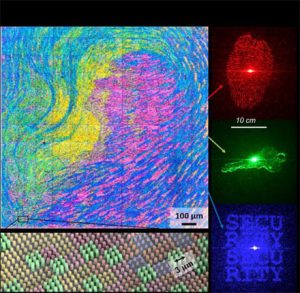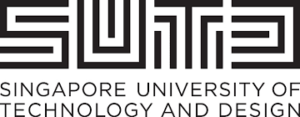Researchers at the Singapore University of Technology and Design (SUTD) are constantly coming up with new discoveries and 3D printing applications, from 3D printed light shows to biocompatible hydrodgels. Now scientists at SUTD have used 3D printing to develop something that not only looks really cool, but can also be used to deter counterfeiting.
The device, which the scientists call “holographic color prints,” creates images that appear as a regular color print under white light. Under red, green or blue laser illumination, the device projects up to three different holograms. It is capable of modulating both the phase and the amplitude of light. The research is documented in a paper entitled “Holographic colour prints for enhanced optical security by combined phase and amplitude control.”
 Conventional optical security devices provide authentication by manipulating a specific property of light to produce a distinctive optical signature. Microscopic color prints modulate the amplitude and holograms modulate the phase of light, but the researchers believe that this structure can be easily imitated. So they designed a pixel that overlays a structural color element onto a phase plate to control both the phase and amplitude of light. They then arrayed the pixels into monolithic prints, with each pixel strategically arranged on a plane. Nanostructured posts with different heights were used as structural colored filters to modulate the amplitude of light.
Conventional optical security devices provide authentication by manipulating a specific property of light to produce a distinctive optical signature. Microscopic color prints modulate the amplitude and holograms modulate the phase of light, but the researchers believe that this structure can be easily imitated. So they designed a pixel that overlays a structural color element onto a phase plate to control both the phase and amplitude of light. They then arrayed the pixels into monolithic prints, with each pixel strategically arranged on a plane. Nanostructured posts with different heights were used as structural colored filters to modulate the amplitude of light.
The researchers also created an algorithm that takes multiple images as its input and generates an output file to determine the positions of different phase and colored filter elements. They then used a nanoscale 3D printer to create a holoscopic print of painter Luigi Russolo’s 1910 painting “Perfume.” The color print is visible under ambient white light. Different thicknesses of polymerized cuboid were used to modulate the phase plates and form three multiplexed holograms, projected as a red thumbprint, a green key, and blue letters that read “SECURITY.” The images were embedded within the print.
The holographic color prints can be easily verified, according to the researchers, but are difficult to imitate.
“The relationship of holograms in combating counterfeiting is analogous to antibiotics against infections,” said professor Joel Yang. “Every so often, new technology is needed to deter counterfeiters as the old-fashioned holograms become easier to copy.”
 The prints consist of nano 3D printed polymer structures and can be used in optical document security. Information in the prints is encoded only in the surface relief of a single polymeric material, so nanoscale 3D printing could then be used to mass manufacture customized masters by nanoimprint lithography.
The prints consist of nano 3D printed polymer structures and can be used in optical document security. Information in the prints is encoded only in the surface relief of a single polymeric material, so nanoscale 3D printing could then be used to mass manufacture customized masters by nanoimprint lithography.
“For the first time, multiple holograms that are color selective are ‘woven’ into a colorful image using advanced nanofabrication techniques,” Yang said. “We are hopeful that these new holographic color prints are user friendly but counterfeiter unfriendly: They are readily verified but challenging to copy, and can provide enhanced security in anticounterfeiting applications.”
Authors of the paper include Kevin T.P. Lim, Hailong Liu, Yejing Liu and Joel K.W. Yang.
Discuss this and other 3D printing topics at 3DPrintBoard.com or share your thoughts below.
[Source: Photonics.com]
Subscribe to Our Email Newsletter
Stay up-to-date on all the latest news from the 3D printing industry and receive information and offers from third party vendors.
You May Also Like
Gorilla Sports GE’s First 3D Printed Titanium Cast
How do you help a gorilla with a broken arm? Sounds like the start of a bad joke a zookeeper might tell, but it’s an actual dilemma recently faced by...
Nylon 3D Printed Parts Made More Functional with Coatings & Colors
Parts 3D printed from polyamide (PA, Nylon) 12 using powder bed fusion (PBF) are a mainstay in the additive manufacturing (AM) industry. While post-finishing processes have improved the porosity of...
$25M to Back Sintavia’s Largest Expansion of Metal 3D Printing Capacity Since 2019
Sintavia, the digital manufacturing company specializing in mission-critical parts for strategic sectors, announced a $25 million investment to increase its production capacity, the largest expansion to its operations since 2019....
Velo3D Initiates Public Offering in a Bid to Strengthen Financial Foundations and Drive Future Growth
Velo3D (NYSE: VLD) has been among a number of publicly traded 3D printing firms that have attempted to weather the current macroeconomic climate. After posting a challenging financial report for 2023,...
































